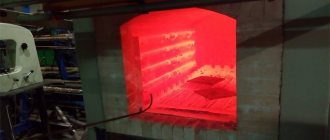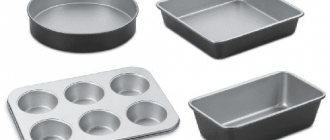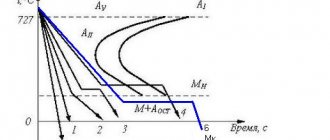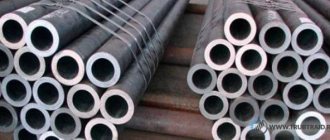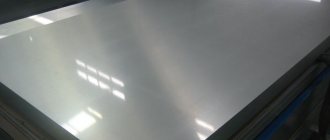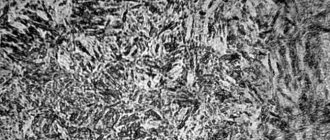Corrosion and its features.
I noticed that while describing the qualities of stainless steels and noting their need and usefulness for industry, I have not yet focused on why they are so important.
The main property of stainless steels is the ability to resist corrosion, so a few words about what it is. Corrosion is the process of destruction of the surface of metals as a result of purely chemical or electrochemical action of the external environment, usually aggressive. In general, metal corrosion is accompanied by the formation of destruction products on the surface, such as rust, but there are also destructions without external manifestations. The intensity of corrosion depends on the properties of the metal and the degree of aggressiveness of the environment.
Corrosion is a fairly broad concept and is characterized by various manifestations:
- continuous (uniform) corrosion, when the entire surface of the metal is destroyed;
- point (local, crevice, pitting) corrosion, when individual areas of the metal surface are destroyed;
- intergranular corrosion, when corrosion spreads deep into the product along the grain boundaries;
- stress corrosion (corrosion cracking), when cracks develop on the metal surface due to the simultaneous influence of tensile stresses and an aggressive environment.
A separate type is electrochemical corrosion, when electrochemical processes at the interface are added to the purely chemical processes of interaction between the metal and the environment. This is the most destructive type of corrosion.
In the process of electrochemical corrosion, the destruction of metals occurs under the influence of electrolytes and is accompanied by the transition of atoms. In practice, most often electrolytes are aqueous solutions of salts, acids and alkalis. Thus, metal containers, pipelines, machine parts and parts of structures in contact with sea and river water, as well as groundwater, are subject to intense destruction by electrochemical corrosion.
From the theory of electrochemical corrosion it follows that very pure metals have the greatest resistance. But in real life, the use of pure metals is practically impossible, so there is a need to ensure a homogeneous structure of the solid solution in alloys.
Increased resistance to uniform corrosion in a wide range of corrosive environments of varying degrees of aggressiveness is a distinctive feature of stainless steels and alloys. Many types of stainless steels are also resistant to intergranular and pitting corrosion and corrosion cracking.
Scope of application of chromium-nickel steels
For the manufacture of equipment for refineries and gas processing plants, regulatory documents provide for the use of a wide range of chromium-nickel steels of both austenitic and austenitic-ferritic classes.
The most common steels are 12Х18Н10Т (08Х18Н10Т), 10Х17Н13М2Т and 10Х17H13M3T. In rare cases, mainly for equipment in contact with sulfuric acid solutions, 06ХН28МДТ steel is used. Along with this, the use of austenitic steels with a reduced carbon content (02Х18Н11, 03Х18Н11, etc.), as well as substitute steels alloyed with manganese (08Х18Г8Н2Т, 07Х13AG20, etc.) is allowed. Austenitic-ferritic steels sparingly alloyed with nickel (08Х22Н6Т, 08Х21Н6М2Т, etc.) are recommended for use. Austenitic steels with low carbon content, substitute steels alloyed with manganese, and austenitic-ferritic steels economically alloyed with nickel have not found wide use in petroleum engineering. In most cases, steels of type 18-10 are used in the temperature range of 196-610°C, steels of type Kh17N13M2T (MZT) - from minus 253 to plus 700°C. The temperature range for using austenitic-ferritic steels is from 0 to 390°C.
In primary oil refining installations, steels of the austenitic and austenitic-ferritic classes are used very limitedly, mainly when operating installations on high-sulfur raw materials. Steel 08Х22Н6Т is recommended for the manufacture of pipes for heat exchange equipment in which water is the cooling agent (coolers for the head and side runs of pre-evaporation columns, atmospheric and vacuum columns, irrigation refrigerators, etc.). They are also recommended for the manufacture of pipes for air cooling apparatus for the head straps of atmospheric and vacuum columns. Such pipes, according to experts, should work for at least 5 years, while pipes and tube bundles made of carbon steel, under the operating conditions of the corresponding condensing and refrigeration equipment, work for less than two years, often less than a year. Austenitic steels of the X18N10T type are not recommended for use in these cases due to the high risk of pitting corrosion and chloride corrosion cracking. Steel 10X17H13M3T is used as cladding to protect fittings of devices, the inner surface of which is protected by non-metallic materials (shotcrete) from the effects of aqueous solutions of salts and hydrogen sulfide present in their working environments. These are electric dehydrators, irrigation tanks for a pre-evaporation column, an atmospheric column, etc. In cases of processing oils with a high content of naphthenic acids, the cladding of part of the body and plate of a vacuum column operating at temperatures above 300°C can be made of steel 10X17H13M3T. However, this method of combating corrosion under the influence of naphthenic acids is not rational, since during the operation of the devices the raw materials entering them may change. It is much simpler and more profitable to use oil compounding.
In recycling plants, austenitic steels are used much more widely. Thus, in catalytic cracking, hydrotreating and reforming plants they are used for the manufacture of internal elements of reactors. The reactors themselves, as a rule, are made of heat-resistant steel with a shotcrete lining. In some cases, the lining is additionally protected from damage by a casing made of steel 08Х18Н10Т. Hydrotreating plants also use bimetal reactors with a cladding layer of steel 08X18H10T. In recent years, furnace coils of hydrotreating units have also been made from steel 08X18N10T - to avoid HTSC.
When processing gases, equipment made of chromium-nickel steels of austenitic and austenitic-ferritic classes is used in sulfur production plants. It is recommended to manufacture pipes of heat exchangers for hydrogen sulfide-containing gas (10Х17Н13М2Т), sulfur trap bumpers (12Х18Н10Т), and internal elements of converters (08X18H10T) from them. heaters for underground collection tanks of liquid sulfur, etc.
General information about chromium-nickel stainless steels.
The main alloying elements that give chromium-nickel steel corrosion resistance in oxidizing environments are Cr (chromium) and Ni (nickel). Chromium promotes the formation of a protective dense passive film of Cr2O3 oxide on the surface of stainless steel. The concentration of chromium in steels of this group required to impart corrosion resistance to stainless steel is 18%.
Nickel belongs to metals that are or easily pass into the so-called “passive” state. In a passive state, a metal or alloy has increased corrosion resistance in an aggressive environment. Although, of course, this ability of nickel is less than that of chromium or molybdenum.
Chromium and iron form a solid solution in the alloy, and nickel in an amount of 9-12%, in addition, contributes to the formation of an austenitic structure. Due to their austenitic structure, chromium-nickel stainless steels are distinguished by high processability during hot and cold deformation and resistance at low temperatures.
Chromium-nickel austenitic stainless steels are the most widespread group of corrosion-resistant steels. They are also known in world practice under the general name of steels of type 18-10.
In our country, the most common grades of chromium-nickel stainless steels are: 12Х18Н10Т, 08Х18Н10Т (EI914), 08Х18Н10, 12Х18Н9Т, 03Х18Н11, 12Х18Н12Т, 08Х18Н12Б (ЭИ402), 02Х18Н11, 03Х19AG 3H10.
These stainless steels exhibit corrosion resistance in many oxidizing environments at varying concentrations and over a wide range of temperatures. They also have heat resistance and heat resistance, but at moderate temperatures.
Application of nickel alloys in medicine
Are you interested in the use of nickel alloys in medicine? The Avek Global company offers to buy nickel rolled products of domestic and foreign production at an affordable price from the manufacturer in a wide range. The supplier Avec Global will ensure delivery of products to any point on the continent. The price is optimal.
Nickel alloys in medicine
Stainless steels that contain nickel, as well as nickel alloys, are widely used for medical purposes. Medical applications include surgical implants, medical instruments, medical equipment and accessories. Piercing can also be considered a cosmetic surgery.
Relevance
Nickel-containing stainless steels are high-strength materials with good corrosion resistance. Increased strength levels can be obtained by modifying the alloy composition or by cold deformation of the material. Nickel-based stainless steel instruments can be repeatedly and effectively sterilized using any disinfectant without destroying the material; Such instruments do not have ferromagnetism, which ensures their compatibility with diagnostic equipment, such as MRI (magnetic resonance imaging).
Implants
Nickel-based stainless steel for implants has good biocompatibility with human tissue. Although there are contraindications for their use. Contraindications include blood diseases and systemic connective tissue diseases. Despite this, most nickel-containing stainless steels are widely used as implant materials. The supplier Avec Global offers to buy nickel of domestic and foreign production at an affordable price from the manufacturer in a wide range. We will ensure delivery of products to any point on the continent. The price is optimal.
Memory effect
Nickel wire, which in its "deformed" form has a small cross-section, can be inserted into the arterial cavity with a reduced likelihood of injury. In place, after being released from the restraining catheter, the wire, under the influence of body heat, returns to the originally “remembered” shape of the spring.
Tools
We list instruments with dynamic properties, such as miniature forceps, clamps and manipulators, devices that can expand, contract, move apart, etc... such instruments allow you to perform complex medical tasks:
- • Help for disabled people
- • Control valves
- • Anti-burn devices
- • Arterial clamps
- • Catheter guide wires
- • Contraception
- • Filter devices
- • Stents for grafts
- • Orthodontic arches
- • Scoliosis correctors
Buy. Supplier, price
Are you interested in the use of nickel alloys in medicine? Supplier Avec Global offers to buy nickel rolled products of domestic and foreign production at an affordable price from the manufacturer in a wide range. The supplier Avec Global will ensure delivery of products to any point on the continent. The price is optimal.
Resistance of stainless steel against intergranular corrosion
The ability to resist intergranular corrosion in chromium-nickel austenitic stainless steels primarily depends on the carbon content of the solid solution. Carbon promotes the release of carbide phases in the solid solution, thereby accelerating the manifestation of intergranular corrosion with increasing temperature.
Chromium-nickel austenitic stainless steels, when held in the range of 750-800 ºС, lose their ability to resist intergranular corrosion:
- with a carbon content of 0.084% - within 1 minute;
- with a carbon content of 0.054% - within 10 minutes;
- at a carbon content of 0.021 5 – after more than 100 minutes.
The nitrogen content in the composition of chromium-nickel austenitic stainless steels also affects the susceptibility to intergranular corrosion, but to a much lesser extent. the presence of nitrogen in the composition may even be useful for increasing strength.
An increase in the concentration of nickel in the composition of chromium-nickel austenitic stainless steels helps to reduce the solubility of carbon, but negatively affects the impact strength of chromium-nickel steel after tempering and promotes intergranular corrosion.
The solubility of carbon in the solid solution of chromium-nickel austenitic stainless steels also occurs with increasing chromium content. In this case, the impact toughness of the steel also decreases, but at the same time the resistance to intergranular corrosion increases.
Chrome-nickel steels
The introduction of more than 7% Ni into chromium steel containing 18% Cr transforms it into an austenitic state (Fig. 7.4). Steel with an austenitic structure, compared to ferritic steel, has better mechanical properties (a combination of high strength and ductility), is less prone to grain growth and is more corrosion resistant.
Rice. 7.4. State diagram at normal temperature of hardened alloys of the Fe-Cr-Ni system containing 0.11% C; Fα - alpha ferrite; P - perlite; M—martensite; Фδ—delta ferrite; K - carbide; Am - metastable austenite; Ac - stable austenite
Depending on the content of chromium and nickel, chromium-nickel steels can have a structure of metastable austenite - steel type 18-10 (18-9): 04Х18Н10, 08Х18Н10, 12Х18Н9, 12Х18Н9Т and stable austenite - steel type 15-25 (for example, 08Х15Н24В4ТР). In steels with metastable austenite, under certain conditions, it is possible for austenite to transform either into martensite (at low temperatures, especially in combination with deformation), or into ferrite with the precipitation of carbides (at elevated temperatures).
In the structure of steel type X18N9, carbides can be observed at a carbon content above the solubility limit (Fig. 7.5, GE curve).
Rice. 7.5. Pseudo-binary state diagram of the Fe—Cr—Ni—C system for the 18% Cr, 8% Ni section
In the temperature range of 500–800 °C at a low cooling rate along the grain boundaries, a predominant precipitation of carbides is observed, leading to the depletion of the boundary layers of austenitic grains in chromium to a content below 12%. As a result of this, the steel becomes prone to intergranular corrosion, since in the galvanic couple “grain body-boundary layer” the grain boundary layer depleted in chromium becomes an anode and, in the presence of an aggressive environment, begins to intensively collapse. Such a change in the composition of the boundary layers of austenite grains is due to the fact that carbon coming from deep within the grain participates in the formation of carbides, and chromium, due to lower diffusion mobility, is supplied to form carbides from the boundary layers.
Long exposure (hundreds of hours) at the same temperatures leads to equalization of chromium concentration within the grain, and the steel becomes resistant to intergranular corrosion.
The precipitation of carbides along grain boundaries depends on the time the steel is in the dangerous temperature range. Rapid cooling of the metal prevents the precipitation of carbides. The tendency to intergranular corrosion can be prevented by keeping the carbon content of the steel below the solubility limit. However, the smelting of such steel encounters significant difficulties.
In most cases, the tendency of steel to intergranular corrosion is prevented by introducing stabilizer elements into the steel: titanium or niobium, which form stable carbides that are poorly soluble in austenite.
The amount of titanium or niobium introduced into steel to prevent intergranular corrosion is prescribed depending on the carbon content. When stabilizing with titanium, the amount of titanium is introduced in the ratio Ti > (5÷7)x(C - 0.02), where 0.02% is carbon in the solid solution. Slightly more titanium is introduced than is required to form TiC carbide (Ti/C ratio = 4). Additional alloying of chromium-nickel steel increases the heat resistance. In this case, the heat resistance increases both due to the strengthening of the steel base - austenite, and due to the formation of additional phases - carbide or intermetallic.
Hardening of austenitic chromium-nickel steels.
Carbon in the composition of austenitic chromium-nickel stainless steels without titanium and niobium additives affects the hardening temperature of the steel. When hardening, it is necessary to heat the steel above the dissolution temperature of chromium carbides; subsequent rapid cooling is intended to fix the homogeneity of the solid solution. Thus, with an increase in carbon content, a higher heating temperature for quenching is required. In general, the heating temperature range during hardening of austenitic chromium-nickel stainless steels ranges from 900 to 1100 ºС.
Long-term holding of austenitic chromium-nickel stainless steels upon reaching the hardening temperature is not required. For sheet stainless steel, the total heating time to 1000-1050 ºС and holding time is 1-3 minutes per 1 mm of sheet thickness.
But cooling should be fast. For austenitic chromium-nickel stainless steels with a carbon content of more than 0.03%, which are classified as “unstabilized,” cooling in water is used. Stainless steels with lower carbon content and small cross-sections can be cooled in air.
Stainless steel 12Х18Н10Т application, properties.
Steel 12Х18Н10Т is an excellent example of chromium-nickel austenitic stainless steel, widely used in the production of welded structures. It can work in contact with nitric acid and other strong oxidizing agents; in some organic acids of medium concentration, organic solvents, atmospheric conditions, etc. These are containers, heat exchangers, as well as welded structures using cryogenic technology (up to -269 °C).
Examples of using stainless steel 12Х18Н10Т:
- rolled forged round, square, hexagonal
- the leaf is thick;
- thin sheet;
- cold rolled strip;
- seamless hot-deformed pipes;
- cold- and heat-deformed seamless pipes;
- wire;
- shaped steel profiles.
The corrosion resistance of stainless steel 12Х18Н10Т against intergranular corrosion is determined by testing according to the AM and AMU methods of GOST 6032-89 with a duration of exposure in the control solution of 24 and 8 hours, respectively. Tests are carried out after provoking heating at 650 °C for 1 hour.
During continuous operation, stainless steel 12Х18Н10Т is resistant to oxidation in air and in the atmosphere of fuel combustion products at temperatures up to 900 °C. Stainless steel 12Х18Н10Т has fairly high heat resistance at temperatures of 600-800 °C.
Stainless steel 12Х18Н10Т, having good manufacturability, can be subject to significant plastic deformation. The temperature range for pressure treatment of stainless steel 12Х18Н10Т is 1180-850 °C, the heating and cooling rates are not limited. When cold, they allow high degrees of plastic deformation.

